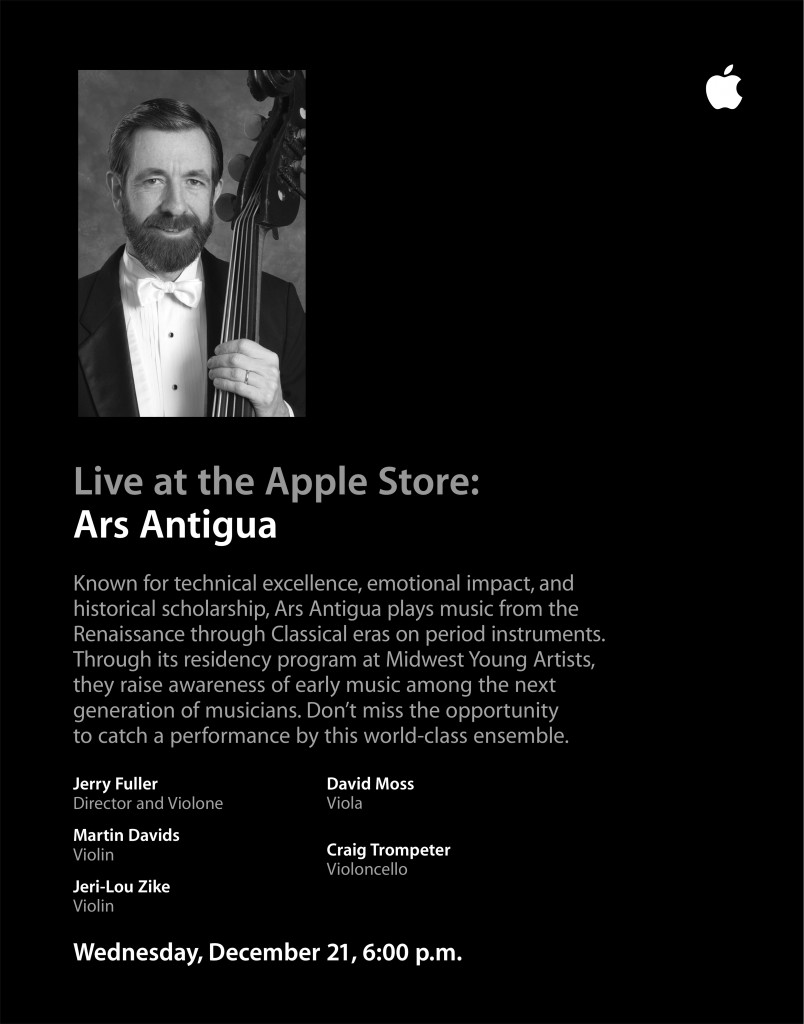Year: 2011
Ars Antigua Presents: December 2011 edition
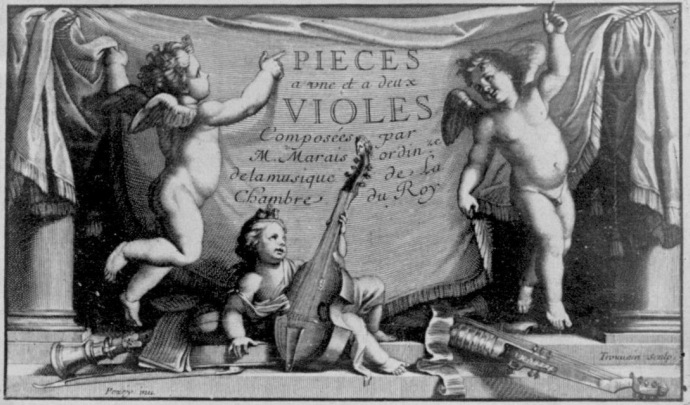
Marin Marais was a virtuoso gambist, performing with the royal orchestra of Louis XIV and the Académie Royale de Musique under the direction of Jean-Baptiste Lully. His skill at composition was also well known in his lifetime; in Le Parnasse François, by Titon du Tillet we learn “one finds everywhere in them good taste and a surprising variety.” Marais composed a few operas and trio sonatas, but the bulk of his output was music for his own basse de viole. Between the years 1686 and 1725, Marais composed five volumes of Pièces de Violes, the most substantial body of work ever written for that instrument. It is from the third volume, published in 1711, that we hear this month’s selection.
This month’s selection includes four Pièces in A minor from the Troisième Livre de Pièces de Viole of Marin Marais. The performers are Les Grâces, a baroque ensemble from the San Francisco bay area, who have just this month released an entire album of music of the French Baroque, titled Les Grâces Françoises.

[12:56]
Podcast produced by Joshua Sauvageau
To all fans of early music…
In September 2011, Wayward Sisters (Ars Antigua Presents featured artists from earlier this year) won the Early Music America/Naxos recording competition. Recordings cost money, however (transportation, rehearsals, etc.) and Wayward Sisters could use some assistance in getting this project off the ground. They have set a modest monetary goal via Kickstarter, complete with excellent rewards for those that back this project. For all fans of early music, please consider giving to support these fine musicians, who will assuredly release an album that we all can enjoy.
Thank you.
Ars Antigua Presents: November 2011 edition
In late 17th-century France, salons were the rage among poets, musicians and intellectual women, many of whom considered the salon setting a sort of informal university. Female composers would often utilize these salons to premiere works for the liberal-minded society in attendance.
Julie Pinel, who lived from the late 17th to early 18th-century was one of those composers who found a welcome home in the Parisian Salon. Coming from a family of musicians who included Germain Pinel, court lutenist to Louis XIV, Julie Pinel published a complete book of songs titled Nouveau recueil d’airs sérieux et à boire. It is from this work that we have drawn today’s selection: “Cantatille: Le Printems”. The lyrics of this lovely air tendre are typical of contemporary salon composers, making several references to nature and pastoral life.
La Donna Musicale have released an entire album devoted to Julie Pinel and her contemporaries.
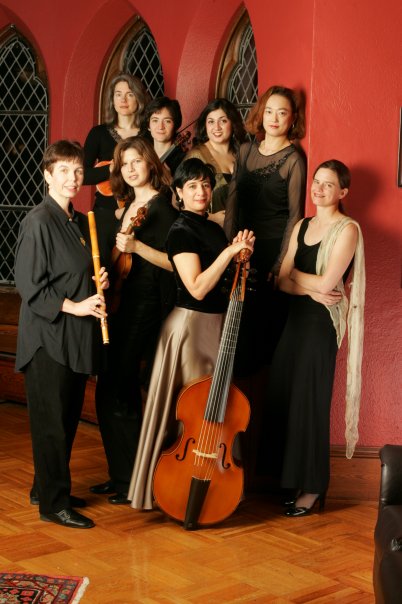
Julie Pinel: “Cantatille: Le Printems“
Recitatif: Le Dieu du jour nous rend lumière féconde,
Son retour enchante nos yeux
Tout rit sur la terre et sur l’onde,
Tout semble renaître en ces lieux.
Le zéphir va s’unir a flore
Bientost de leur tenders amours
Nous allons voir éclore
Mille fleurs avec les beaux jours…
Air: Chantez, dansez jeunes bergères,
A l’ombre des ses frais ormeaux,
Unissez vos danses légères
Aux doux son de nos chalumeaux.
Que l’amour qui regne en nos âmes
Nous inspire de nouveaux sons.
Célébrons l’ardeur de nos flâmes
Par les plus aimable chansons.
Recitatif: Déjà la riante verdure,
Fruit de l’haleine des zéphirs
Embellit toute la nature, et rameine
En ces lieux les jeux et les plaisirs,
Tout ressent de l’amour la Suprême puissance,
Toy seule belle Iris par ton indifférence
Veux tu payer toujours les tenders feux
De mon cœur amoureux,
Ecoute les ramages
De ces heureux oiseaux
Ils t’invittent sous ces feuillages
A soulager mes meaux.
Air: Doux Rossignols chantez dans ces boccages,
Chantez votre bonheur, je n’en suis point jaloux.
Que vos chants amoureux deviennent les présages
D’un plaisir qui me rend aussy content que vous.
Attendrissez mon aimable inhumaine
Peignez lui l’ardeur que je sens
Qu’elle partage enfin ma peine
Redoublez vos divins accens.
[14:02]
Podcast produced by Joshua Sauvageau
Ars Antigua Presents: October 2011 edition
Originally published in 1651 by John Playford, the first edition of The English Dancing Master contained over one hundred country dances and ballad airs. This extremely popular volume, which went through several editions over the subsequent 75 years, described the method of performing these dances, and gave a melodic line for each. As many musicians have done since the first publication of this work, Musica Pacifica have created their own arrangements of melodies from The English Dancing Master. Today, we will hear five of these virtuosic arrangements. First is “Newcastle,” which incorporates a two-part setting by violinist David Douglass, following that is the lively “Rufty Tufty,” and then a morose air called “Irish Lamentation.” The fourth dance is an up-tempo “Scotch Cap” and rounding out the selection will be the whimsical “Jack’s Maggot.”
country dances and ballad airs. This extremely popular volume, which went through several editions over the subsequent 75 years, described the method of performing these dances, and gave a melodic line for each. As many musicians have done since the first publication of this work, Musica Pacifica have created their own arrangements of melodies from The English Dancing Master. Today, we will hear five of these virtuosic arrangements. First is “Newcastle,” which incorporates a two-part setting by violinist David Douglass, following that is the lively “Rufty Tufty,” and then a morose air called “Irish Lamentation.” The fourth dance is an up-tempo “Scotch Cap” and rounding out the selection will be the whimsical “Jack’s Maggot.”
Musica Pacifica perform English Country Dances:
(Video courtesy of Musica Pacifica)
[11:25]
Podcast produced by Joshua Sauvageau
Ars Antigua Presents: September 2011 edition
A masterful musician who detested performing publicly, Nicola Matteis was an Italian-born violinist, guitarist and composer who spent much of his career in England. While we don’t have many hard facts about his life (we don’t even know his precise birth or death dates) we do know that Matteis had a reputation for being an arrogant and “inexpugnably proud” man who would only stoop to giving public concerts when his finances demanded it.
Importing an Italian performance style, Matteis became a key figure in the development of violin playing in England and his compositions displayed a variety of bowings that exceeded any found in English music up to that point. Matteis’ major contribution to the literature was four books of Ayres for the Violin, published between 1676 and 1687. Today, we will hear two movements from his Suite in d minor from Book Four of that work, performed by The Wayward Sisters. First is a melancholic adagio marked “A Grave Thing”. This is followed by a dancelike “Ground with Several Divisions”.
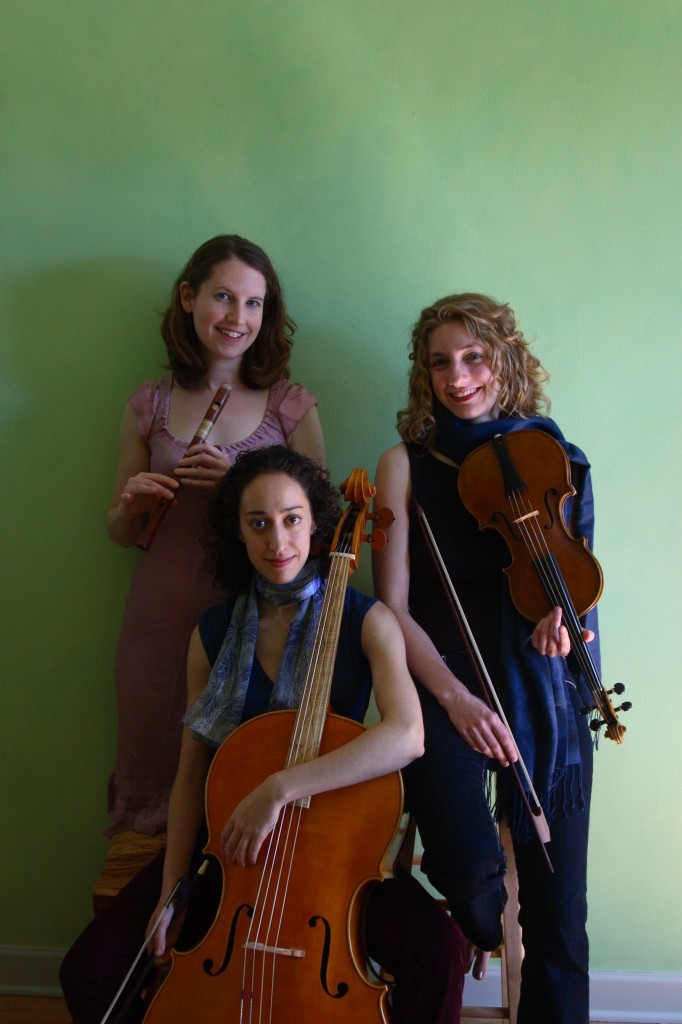
The Wayward Sisters:
Beth Wenstrom-baroque violin
Anne Timberlake-recorder
Anna Steinhoff-baroque cello
John Lenti-theorbo
[08:27]
Podcast produced by Joshua Sauvageau
Ars Antigua Presents: August 2011 edition
 “If music be the food of love, play on.”
“If music be the food of love, play on.”
On this edition of Ars Antigua Presents, we’ll hear selections from Shakespeare’s Songbook: music and dialogue from the Bard’s plays.
Popular songs of Elizabethan England played an important role in many of Shakespeare’s plays. Shakespeare frequently chose to insert these songs to reveal the thoughts and emotions of his characters or to help set the scene. Today’s selections provide a rare sonic glimpse at the rich soundscape of Shakespeare’s theater.
Robert Johnson, an English composer and lutenist, was a contemporary of Shakespeare. We will hear two of his best-known songs, “Full fathom five” and “Where the bee sucks,” which are settings of dialogue from the Bard’s final play, The Tempest. Following these, we will hear a brief ‘Shepherd’s Dance’ by Dutch composer and music publisher, Tielman Susato. This festive, early-16th century tune would have provided a fitting accompaniment to the shepherd’s scene in Shakespeare’s The Winter’s Tale.
We hear now, in these performances, members of the Chicago Early Music Consort.
[08:44]
Podcast episode produced by Joshua Sauvageau.
Ars Antigua Presents: July 2011 edition
This month we’re featuring Musique de Joye—joyous songs and dances from 16th century France.
Social and political conditions in France during the 16th century were particularly favorable to the growth of popular music. During the long reign of Francis I (1515-47), French composers developed a uniquely new song form, the chanson, which was distinctly national in both poetry and music. While chansons were typically written for voices in polyphony, in the mid-16th century hundreds of chanson transcriptions for the lute and arrangements for solo voice with lute accompaniment were also published.
One of the most prolific and versatile of all 16th century composers, Roland de Lassus [1532-1594] penned over 150 chansons. Covering subjects as diverse as nature, biblical themes and bawdy narratives, Lassus’s chansons were popular in his native France as well as the Munich court, where he spent most of his career. Today we’ll hear his setting of “Bonjour mon coeur,” with text by a French contemporary of Lassus, the poet Pierre de Ronsard [1524-1585].
After “Bonjour mon coeur,” we will hear an anonymous chanson, arranged for solo lute, “Branle simple,” followed by “Changeons propos,” by a master of the Renaissance chanson, Claudin de Sermisy.
In these performances we will hear members of the Chicago Early Music Consort, under the direction of Gary Berkenstock:
Gary Berkenstock—recorder
Stephanie Sheffield—soprano
Phillip W. Serna—bass viol
Joel Spears—lute
Podcast episode produced by Joshua Sauvageau.
Ars Antigua Presents: June 2011 Edition
Today we’re featuring two beautiful soprano arias by George Frederic Handel, whose vocal music made him the toast of London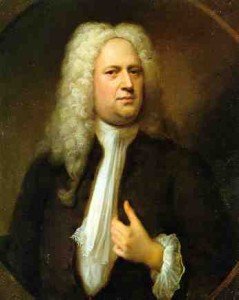 in the first half of the eighteenth century. We’ll hear “Lascia ch’io pianga” from the 1711 opera Rinaldo and “Tornami a vagheggiar” from Alcina, written a quarter decade later.
in the first half of the eighteenth century. We’ll hear “Lascia ch’io pianga” from the 1711 opera Rinaldo and “Tornami a vagheggiar” from Alcina, written a quarter decade later.
Both are examples of the ternary “da capo aria” form, in which the first “A” section returns near the end, sometimes with a great deal of embellishment and ornamentation improvised by the singer. Vocalists and divas of Handel’s time loved the opportunity to put their prowess on full display, and audiences delighted in filling opera houses like the Queen’s Theater and the Covent Garden to take in the spectacle.
This performance is presented by Ars Antigua under the direction of Jerry Fuller with Kathryn Mueller, soprano.
[10:58]
Ars Antigua Presents: May 2011 edition
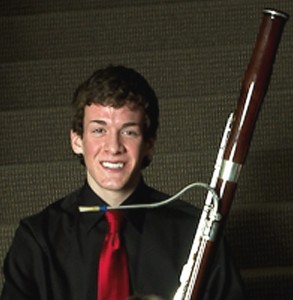 Today we’re featuring one of the most recent winners of the Walgreens National Concerto Competition, which celebrated its 15th anniversary this year. This annual contest, sponsored in conjunction with Midwest Young Artists, selected bassoonist JJ Sechan as the winner of the Senior Division’s Early Music category.
Today we’re featuring one of the most recent winners of the Walgreens National Concerto Competition, which celebrated its 15th anniversary this year. This annual contest, sponsored in conjunction with Midwest Young Artists, selected bassoonist JJ Sechan as the winner of the Senior Division’s Early Music category.
JJ has been enrolled in MYA since the Fall of 2007, and is a member of Quintethero, MYA’s top woodwind quintet. It’s a group that has been featured on WFMT’s Introductions and on NPR’s From the Top, and was also selected as the winner of the 2010 Chicago Chamber Music Competition. JJ was chosen as Principal Bassoon of the 2010 Illinois All-State Honors Band as well as Principal Bassoon of the MYA Symphony Orchestra and District 7 Illinois Music Education Association Festival a number of times.
JJ plans to attend either the Conservatory at Oberlin College or the Juilliard School in the fall, majoring in bassoon performance and microbiology.
Here is JJ Sechan performing the first movement of Mozart’s Bassoon Concerto with the orchestra at Midwest Young Artists.
[8:59]
Ars Antigua Presents: April 2011 edition
Today we’re featuring soft cialis three canzonas of Girolamo Frescobaldi, an Italian composer born in 1583 who spent some time in Antwerp before being named the organist at St. Peter’s Basilica in 1608.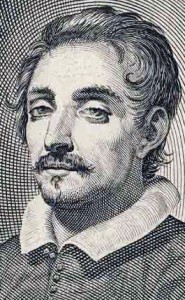
These pieces are played on members of the viola da gamba family, a name that literally translates to “viol of the leg”. Even the smaller instruments are held upright between the knees, in a distinctly different fashion from the violas da braccio, or “viols of the arm”, the predecessors of the modern-day violin. Gambas are fretted and come in various sizes, including the treble and bass versions that we’ll hear today accompanied by the largest member of the gamba family, the violone.
In this performance:
Craig Trompeter and Russell Wagner, gambas
Jerry Fuller, violone
David Schrader, organ
[13:03]
Ars Antigua Presents: March 2011 edition
 Hello, and welcome to the March 2011 edition of Ars Antigua Presents, a free monthly podcast of music from the Renaissance, Baroque, and Classical eras. Today we’re featuring a suite of instrumental music from Jean-Phillipe Rameau’s opéra-ballet Les Indes Galantes, first performed at the Paris Opéra in 1735. In it, we hear the allure that anything exotic had for so many Baroque artists and composers, as a story of Cupid seeking out love in distant climes is told. After an overture, representatives of four nations make their entrance onto the stage- the Turks, the Incans, the Persians, and native Americans. Though Rameau never traveled to any of the foreign lands he depicts, he nevertheless had a grand time depicting the ways in which their citizens universally fall victim to Cupid’s machinations.
Hello, and welcome to the March 2011 edition of Ars Antigua Presents, a free monthly podcast of music from the Renaissance, Baroque, and Classical eras. Today we’re featuring a suite of instrumental music from Jean-Phillipe Rameau’s opéra-ballet Les Indes Galantes, first performed at the Paris Opéra in 1735. In it, we hear the allure that anything exotic had for so many Baroque artists and composers, as a story of Cupid seeking out love in distant climes is told. After an overture, representatives of four nations make their entrance onto the stage- the Turks, the Incans, the Persians, and native Americans. Though Rameau never traveled to any of the foreign lands he depicts, he nevertheless had a grand time depicting the ways in which their citizens universally fall victim to Cupid’s machinations.
In this performance from the Music Institute of Chicago, we’ll hear violinist and leader Garry Clarke direct the Baroque Band. Jean Phillipe Rameau’s first suite from Les Indes Galantes.
Podcast length: [14:52]
